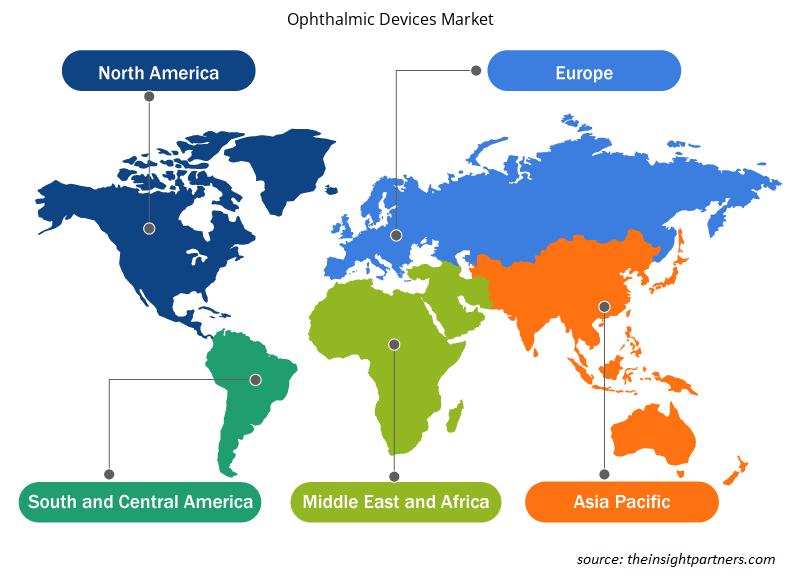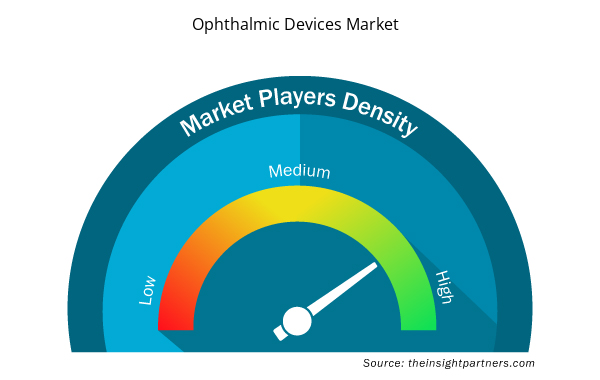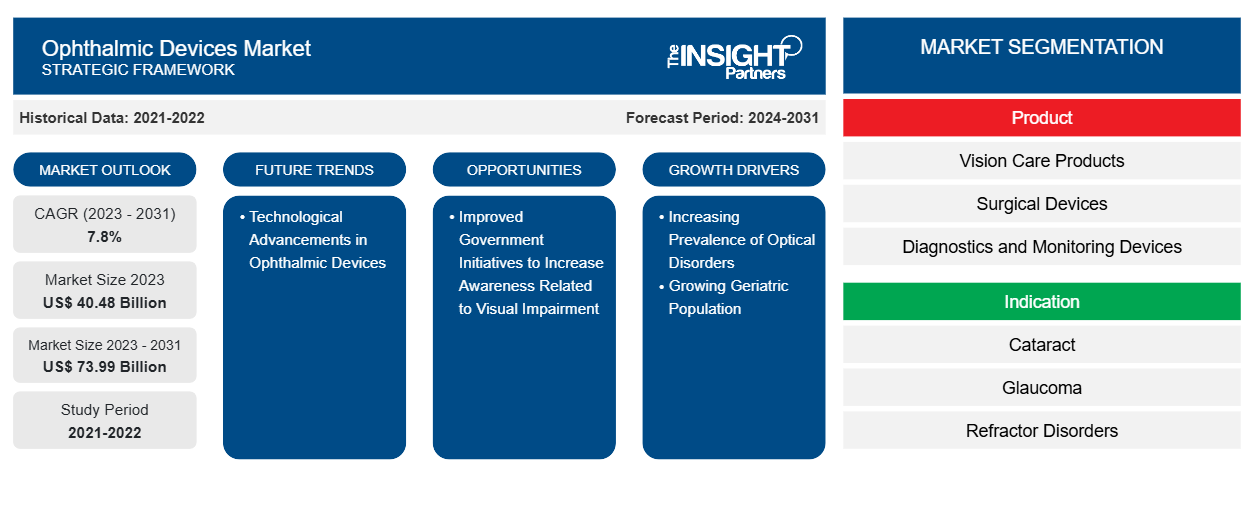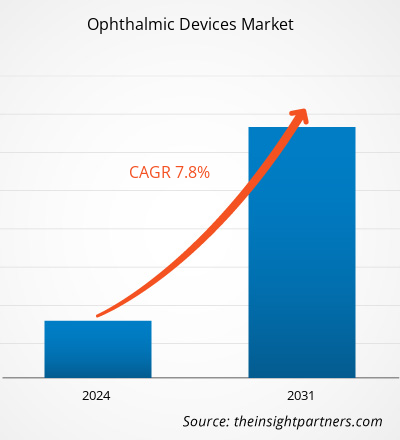眼科用機器の市場規模は、2023年の404.8億米ドルから2031年には739.9億米ドルに達すると予測されており、2023年から2031年の間に市場は7.8%のCAGRを記録すると推定されています。
眼科用機器は、視力矯正、診断、手術目的で使用される医療機器です。緑内障、白内障、その他の視力関連疾患の症例の増加により、近年、眼科用機器の認知度と採用が急増しています。高齢者人口の増加と視覚障害の有病率の急増により、今後数年間で眼科用機器市場が活性化すると予測されています。眼科用機器市場の動向には、将来の市場の成長に有利となる眼科用機器の技術的進歩が含まれています。
成長の原動力:
米国、英国、カナダ、日本などの先進国や、中国、インド、韓国などの発展途上国における老年人口の急増は、医療施設の近代化と医療サービスの向上によって推進されており、これらの国では平均寿命が延びています。高齢化は世界の社会経済面に大きな影響を与えています。高齢者を安全かつ効果的に治療するために、世界各国で新しい技術が採用されています。そのため、生活の質が向上したために死亡率が低下し、老年人口の急増を引き起こしています。世界保健機関の2022年のデータによると、2030年までに6人に1人が60歳以上になります。 60歳以上の人口は、2021年の9億人から2050年までに20億人に増加すると予想されています。この年齢層の世界人口の割合は、2015年の12%から2050年までに22%に倍増します。経済社会局の2019年の国連報告書によると、約7億300万人が65歳以上であり、その数は2050年までに15億人に倍増すると推定されています。
緑内障は60歳以上の人の失明の主な原因であり、60歳を超えると緑内障を発症する可能性が6倍高くなります。国立緑内障研究ファクトシート2022によると、300万人以上のアメリカ人が緑内障を患っており、そのうち270万人が40歳以上です。その他の失明の原因には、糖尿病網膜症、加齢黄斑変性、網膜剥離などがあります。米国疾病管理予防センターによると、2021年の米国における糖尿病網膜症の有病率は25歳未満の人(13.0%)で最も低く、65~79歳の年齢層(28.4%)で最も高くなっています。加齢に伴う眼疾患は、米国における失明や低視力の主な原因としても挙げられています。したがって、高齢化社会では早期診断と治療を必要とするさまざまな眼疾患にかかりやすくなり、それが眼科機器の需要を促進し、眼科機器市場の成長に貢献しています。
要件に合わせてレポートをカスタマイズする
このレポートの一部、国レベルの分析、Excelデータパックなど、あらゆるレポートを無料でカスタマイズできます。また、スタートアップや大学向けのお得なオファーや割引もご利用いただけます。
- このレポートの主要な市場動向を入手してください。この無料サンプルには、市場動向から見積もりや予測に至るまでのデータ分析が含まれます。
レポートのセグメンテーションと範囲:
眼科用機器市場の分析は、製品、適応症、エンドユーザー、および地理の以下のセグメントを考慮して実施されています。製品に基づいて、市場は視覚ケア製品、外科用機器、診断およびモニタリング機器に分割されています。適応症に関しては、市場は白内障、緑内障、屈折異常、およびその他の適応症に分類されています。エンドユーザーに基づいて、市場は病院と眼科クリニック、学術研究機関、およびその他のエンドユーザーに分類されています。眼科用機器市場レポートの範囲は、北米(米国、カナダ、メキシコ)、ヨーロッパ(フランス、ドイツ、英国、スペイン、イタリア、その他のヨーロッパ)、アジア太平洋(中国、日本、インド、韓国、オーストラリア、その他のアジア太平洋)、中東およびアフリカ(サウジアラビア、南アフリカ、UAE、その他の中東およびアフリカ)、南米および中米(ブラジル、アルゼンチン、その他の南米および中米)をカバーしています。
セグメント分析:
眼科機器市場は、製品別に、視覚ケア製品、外科用機器、診断およびモニタリング機器に分類されます。視覚ケア製品セグメントは、2023年に大きな市場シェアを占めました。2023年から2031年にかけて、市場で最高のCAGRを記録すると予想されています。
適応症に基づいて、市場は白内障、緑内障、屈折異常、およびその他の適応症に分類されます。緑内障セグメントは、2023年に眼科機器市場で大きなシェアを占め、2023年から2031年の間に最高のCAGRを記録すると予測されています。
エンドユーザーに基づいて、市場は病院と眼科クリニック、学術研究機関、およびその他のエンドユーザーに分割されています。病院と眼科クリニックのセグメントは、2023年に眼科機器市場で大きなシェアを占め、2023年から2031年の間に最高のCAGRを記録すると予想されています。
地域分析:
地理的には、眼科用機器市場は、北米、ヨーロッパ、アジア太平洋、中南米、中東およびアフリカに分割されています。 2023年には、北米が市場の大きなシェアを獲得しました。 2023年には、米国がこの地域の眼科用機器市場を支配しました。 北米での市場成長は、白内障、緑内障、糖尿病性網膜症、加齢黄斑変性症(AMD)、屈折異常などの眼疾患の負担の増加、高齢者人口の増加、技術的に高度な眼科機器の急増、およびこの地域における重要な市場プレーヤーの存在に起因しています。 65歳以上の人口が急増する中、米国ではAMDなどの加齢関連疾患の症例が増加しています。米国国立衛生研究所の報告書によると、AMDの患者数は2000年から2010年にかけて18%増加し、2000年の175万人から2010年には207万人に達しました。2050年までに、その数は207万人から544万人に達すると予測されています。2023年に発表された研究「2021年の米国における糖尿病網膜症の有病率」によると、2021年の米国では約960万人が糖尿病網膜症を患っており、約180万人が視力を脅かす糖尿病網膜症を患っています。これにより、診断用眼科ツールの需要が高まり、この地域の眼科機器市場の成長が促進されます。
眼科用機器市場の地域別分析
予測期間を通じて眼科用機器市場に影響を与える地域的な傾向と要因は、Insight Partners のアナリストによって徹底的に説明されています。このセクションでは、北米、ヨーロッパ、アジア太平洋、中東、アフリカ、南米、中米にわたる眼科用機器市場のセグメントと地理についても説明します。

- 眼科用機器市場の地域別データを入手
眼科用機器市場レポートの範囲
| レポート属性 | 詳細 |
|---|---|
| 2023年の市場規模 | 404.8億米ドル |
| 2031年までの市場規模 | 739.9億米ドル |
| 世界のCAGR(2023年~2031年) | 7.8% |
| 履歴データ | 2021-2022 |
| 予測期間 | 2024-2031 |
| 対象セグメント | 製品別
|
| 対象地域と国 | 北米
|
| 市場リーダーと主要企業プロフィール |
|
眼科用機器市場のプレーヤー密度:ビジネスダイナミクスへの影響を理解する
眼科用機器市場は、消費者の嗜好の変化、技術の進歩、製品の利点に対する認識の高まりなどの要因により、エンドユーザーの需要が高まり、急速に成長しています。需要が高まるにつれて、企業は提供を拡大し、消費者のニーズを満たすために革新し、新たなトレンドを活用し、市場の成長をさらに促進しています。
市場プレーヤー密度とは、特定の市場または業界内で活動している企業または会社の分布を指します。これは、特定の市場スペースに、その市場規模または総市場価値に対してどれだけの競合相手 (市場プレーヤー) が存在するかを示します。
眼科用機器市場で事業を展開している主要企業は次のとおりです。
- アルコン、
- トプコン、
- ボシュロム、
- カールツァイスメディテック、
- ハーグ・シュトライト・ホールディング、
- エシロール、
免責事項:上記の企業は、特定の順序でランク付けされていません。

- 眼科用機器市場のトップキープレーヤーの概要を入手
業界の発展と将来の機会:
眼科用機器市場レポートには、市場における競合他社のパフォーマンスを評価するための企業の位置付けと集中が含まれています。企業のプレスリリースによると、市場で活動している主要企業が行ったいくつかの取り組みは以下のとおりです。
- トプコンは、2021年7月にイタリアのフィレンツェ郊外に本社を置く眼科機器メーカーVISIA Imaging Srlを買収しました。この買収により、トプコンは眼底カメラや光干渉断層撮影装置など、優位な立場にある眼底イメージング機器のポートフォリオをさらに強化する予定です。この買収により、トプコンの前眼部デバイスとソフトウェアの開発および製造能力が向上します。また、この買収は、トプコンが眼科診断ツールのトップメーカーとしての地位を強化することを目的としています。
- 2021年3月、Iridex CorporationはTopcon Corporationと戦略的提携を締結しました。Iridex Corporationは、緑内障や網膜疾患の治療のための革新的な眼科用レーザーベースの医療製品の有名なプロバイダーです。IridexはTopconのPASCAL製品ラインを買収し、独自のMicroPulseテクノロジーとTopconのPASCALレーザープラットフォームを組み合わせて、網膜スキャンレーザー製品の市場でのシェアを拡大しました。
競争環境と主要企業:
眼科用機器市場の予測は、関係者が成長戦略を計画するのに役立ちます。アルコン、トプコン、ボシュロム、カールツァイスメディテック、ハーグ・シュトライト・ホールディング、エシロール、ジョンソン・エンド・ジョンソン・ビジョン、ニデック株式会社、ホヤ株式会社、クーパービジョンは、この市場でプロファイルされている主要なプレーヤーの一部です。これらの企業は、世界中で高まる消費者の需要を満たすために、新しいハイテク製品の導入、既存製品の改良、地理的拡大に重点を置いています。
- 過去2年間の分析、基準年、CAGRによる予測(7年間)
- PEST分析とSWOT分析
- 市場規模価値/数量 - 世界、地域、国
- 業界と競争環境
- Excel データセット
- Vertical Farming Crops Market
- Environmental Consulting Service Market
- Adaptive Traffic Control System Market
- Industrial Inkjet Printers Market
- Sweet Potato Market
- Radiopharmaceuticals Market
- Hand Sanitizer Market
- 3D Mapping and Modelling Market
- Investor ESG Software Market
- Real-Time Location Systems Market

Report Coverage
Revenue forecast, Company Analysis, Industry landscape, Growth factors, and Trends

Segment Covered
This text is related
to segments covered.

Regional Scope
North America, Europe, Asia Pacific, Middle East & Africa, South & Central America

Country Scope
This text is related
to country scope.
よくある質問
The ophthalmic devices market was valued at US$ 40.48 billion in 2023.
The global ophthalmic devices market is segmented based on by product, indication, and end user. The ophthalmic devices market, by product, is categorized into vision care products, surgical devices, and diagnostics and monitoring devices. The vision care products segment held a significant market share in 2023 and is anticipated to record the highest CAGR in the market during 2023–2031.
The ophthalmic devices market majorly consists of the players, including Alcon, Topcon, Bausch + Lomb, Carl Zeiss Meditec, Haag Streit Holding, Essilor, Johnson & Johnson Vision, Nidek Co. Ltd, Hoya Corporation, and CooperVision.
The factors driving the growth of the ophthalmic devices market include the increasing prevalence of optical disorders and the growing geriatric population. However, high cost of devices hampers the growth of the ophthalmic devices market.
The ophthalmic devices market is expected to be valued at US$ 73.79 billion in 2031.
The ophthalmic devices are used for diagnosis, surgical, and vision correction purposes. These devices include invasive devices such as implantable devices (intraocular lenses and glaucoma stents), and noninvasive diagnostic equipment and instruments. The adoption of these devices has increased due to increasing cases of glaucoma, cataract, and other vision-related issues worldwide.
Trends and growth analysis reports related to Life Sciences : READ MORE..
The List of Companies - Ophthalmic Devices Market
- Alcon
- Topcon Corp.
- Bausch + Lomb
- Carl Zeiss Meditec
- Haag?Streit Holding
- Essilor
- Johnson & Johnson Vision
- Nidek Co. Ltd
- Hoya Corporation
- CooperVision.
The Insight Partners performs research in 4 major stages: Data Collection & Secondary Research, Primary Research, Data Analysis and Data Triangulation & Final Review.
- Data Collection and Secondary Research:
As a market research and consulting firm operating from a decade, we have published and advised several client across the globe. First step for any study will start with an assessment of currently available data and insights from existing reports. Further, historical and current market information is collected from Investor Presentations, Annual Reports, SEC Filings, etc., and other information related to company’s performance and market positioning are gathered from Paid Databases (Factiva, Hoovers, and Reuters) and various other publications available in public domain.
Several associations trade associates, technical forums, institutes, societies and organization are accessed to gain technical as well as market related insights through their publications such as research papers, blogs and press releases related to the studies are referred to get cues about the market. Further, white papers, journals, magazines, and other news articles published in last 3 years are scrutinized and analyzed to understand the current market trends.
- Primary Research:
The primarily interview analysis comprise of data obtained from industry participants interview and answers to survey questions gathered by in-house primary team.
For primary research, interviews are conducted with industry experts/CEOs/Marketing Managers/VPs/Subject Matter Experts from both demand and supply side to get a 360-degree view of the market. The primary team conducts several interviews based on the complexity of the markets to understand the various market trends and dynamics which makes research more credible and precise.
A typical research interview fulfils the following functions:
- Provides first-hand information on the market size, market trends, growth trends, competitive landscape, and outlook
- Validates and strengthens in-house secondary research findings
- Develops the analysis team’s expertise and market understanding
Primary research involves email interactions and telephone interviews for each market, category, segment, and sub-segment across geographies. The participants who typically take part in such a process include, but are not limited to:
- Industry participants: VPs, business development managers, market intelligence managers and national sales managers
- Outside experts: Valuation experts, research analysts and key opinion leaders specializing in the electronics and semiconductor industry.
Below is the breakup of our primary respondents by company, designation, and region:

Once we receive the confirmation from primary research sources or primary respondents, we finalize the base year market estimation and forecast the data as per the macroeconomic and microeconomic factors assessed during data collection.
- Data Analysis:
Once data is validated through both secondary as well as primary respondents, we finalize the market estimations by hypothesis formulation and factor analysis at regional and country level.
- Macro-Economic Factor Analysis:
We analyse macroeconomic indicators such the gross domestic product (GDP), increase in the demand for goods and services across industries, technological advancement, regional economic growth, governmental policies, the influence of COVID-19, PEST analysis, and other aspects. This analysis aids in setting benchmarks for various nations/regions and approximating market splits. Additionally, the general trend of the aforementioned components aid in determining the market's development possibilities.
- Country Level Data:
Various factors that are especially aligned to the country are taken into account to determine the market size for a certain area and country, including the presence of vendors, such as headquarters and offices, the country's GDP, demand patterns, and industry growth. To comprehend the market dynamics for the nation, a number of growth variables, inhibitors, application areas, and current market trends are researched. The aforementioned elements aid in determining the country's overall market's growth potential.
- Company Profile:
The “Table of Contents” is formulated by listing and analyzing more than 25 - 30 companies operating in the market ecosystem across geographies. However, we profile only 10 companies as a standard practice in our syndicate reports. These 10 companies comprise leading, emerging, and regional players. Nonetheless, our analysis is not restricted to the 10 listed companies, we also analyze other companies present in the market to develop a holistic view and understand the prevailing trends. The “Company Profiles” section in the report covers key facts, business description, products & services, financial information, SWOT analysis, and key developments. The financial information presented is extracted from the annual reports and official documents of the publicly listed companies. Upon collecting the information for the sections of respective companies, we verify them via various primary sources and then compile the data in respective company profiles. The company level information helps us in deriving the base number as well as in forecasting the market size.
- Developing Base Number:
Aggregation of sales statistics (2020-2022) and macro-economic factor, and other secondary and primary research insights are utilized to arrive at base number and related market shares for 2022. The data gaps are identified in this step and relevant market data is analyzed, collected from paid primary interviews or databases. On finalizing the base year market size, forecasts are developed on the basis of macro-economic, industry and market growth factors and company level analysis.
- Data Triangulation and Final Review:
The market findings and base year market size calculations are validated from supply as well as demand side. Demand side validations are based on macro-economic factor analysis and benchmarks for respective regions and countries. In case of supply side validations, revenues of major companies are estimated (in case not available) based on industry benchmark, approximate number of employees, product portfolio, and primary interviews revenues are gathered. Further revenue from target product/service segment is assessed to avoid overshooting of market statistics. In case of heavy deviations between supply and demand side values, all thes steps are repeated to achieve synchronization.
We follow an iterative model, wherein we share our research findings with Subject Matter Experts (SME’s) and Key Opinion Leaders (KOLs) until consensus view of the market is not formulated – this model negates any drastic deviation in the opinions of experts. Only validated and universally acceptable research findings are quoted in our reports.
We have important check points that we use to validate our research findings – which we call – data triangulation, where we validate the information, we generate from secondary sources with primary interviews and then we re-validate with our internal data bases and Subject matter experts. This comprehensive model enables us to deliver high quality, reliable data in shortest possible time.




 Get Free Sample For
Get Free Sample For